|
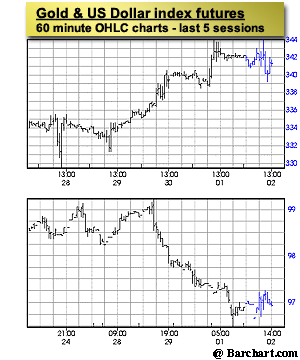 Friday
was a fabulous day for the gold sector even if gold prices didn't
participate much themselves, yet. Friday
was a fabulous day for the gold sector even if gold prices didn't
participate much themselves, yet.
Gold stocks had their best one day
gain since December. They closed up on the day about as much as
they did on the week - to illustrate how sluggish trade has been.
The AMEX Gold bugs index surged almost 8% Friday. But it still was
runner up to the S&P gold sector index, which was up 8.3% on
the day.
Shares of Durban, Glamis, Goldcorp,
IAMGold, Goldenstar, and Hecla Mining were up more than 10%. Anglogold
and Newmont were both up better than 8%. Anglo and Newmont are the
world's two largest gold miners if you weren't already aware of
it.
To be sure, gold and the main gold
sector averages still have resistance to contend with - 125 to 135
in the HUI, and $335 to $360 for gold - even if the longer term
trends are intact. However,
the rally in gold shares looked bullish, and may underscore our
outlook, that the worst is
behind for this sector. I get particularly excited, from a technical
point of view, when gold shares trade as strongly as they did on
Friday, just when the Dow is turning down. Gold shares tend to be
a leading argument you see, at least at the healthier stages of
a gold bull.
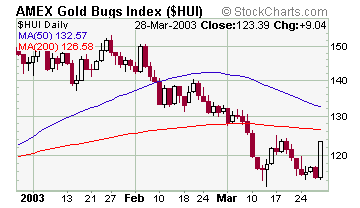 Newmont
released its quarter and year end numbers Friday morning. They were
held up due to a difference of opinion between the company and the
SEC over the accounting for its recent acquisitions. Nevertheless,
buried in the quarterly report was news with
bullish implications. I think it was the catalyst for Friday's move. Newmont
released its quarter and year end numbers Friday morning. They were
held up due to a difference of opinion between the company and the
SEC over the accounting for its recent acquisitions. Nevertheless,
buried in the quarterly report was news with
bullish implications. I think it was the catalyst for Friday's move.
The results came on Friday. Earnings
were $0.42 cents per share, compared to a loss of 28 cents in 2001.
The news was better than expected. There were criticisms that the
fourth quarter numbers looked better than normal because of the
restatement of earnings in the first nine months, and the 6 cent
per share tax benefit in Q4. But the full year figures largely excluded
the impact of the adjustment. And there was no tax benefit for the
full year.
However, that's not the exciting
news we're talking about.
The gold sector took off after Newmont's
release, which came before the bell. Only later did the press begin
to notice that Newmont updated the status of its hedgebook as of
March 26, 2003.
| Excerpt from Newmont's Quarterly Report:
As of March 26, 2003, the company had
repurchased 804,000 committed ounces and delivered 449,000 committed
ounces for the year, reducing its committed hedge position to
3.9 million ounces. Newmont will continue to evaluate opportunities
to further deliver into, close out and simplify these gold hedge
books - March 28, 2003 |
Newmont announced it had bought back
804,000 committed ounces and delivered 449,000 ounces of hedges
in the first quarter up to last Tuesday, over and above the 500,000
ounces covered in the fourth quarter 2002 - see the text in the
box to the right. What does it mean?
In a recent issue we showed clearly
that the hedged gold producers weren't achieving full share valuations.
In particular, we showed how Newmont's share values have sunk to
a discount vis-à-vis their fair market values since the third
quarter of last year, while the other (unhedged) producers continued
to command a premium. In other words, the market began pricing a
risk premium similar to what we uncovered to be the case in all
the other hedged producers' shares.
Note in Chart 1 that Newmont's shares
traded persistently near par - to our valuation estimates - until
about the third quarter of last year when they traded at an increasing
discount. This wasn't the case with the unhedged producers, which
continue to trade at or above par (par is our theoretical fair market
value), on average.
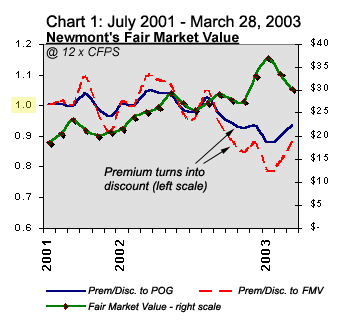 But
it certainly is the case that the hedged producers, almost regardless
of the size of their relative hedges are being endowed a higher
risk premium because of them. But
it certainly is the case that the hedged producers, almost regardless
of the size of their relative hedges are being endowed a higher
risk premium because of them.
In our small sample of producers,
the average hedged producer trades at
an (unweighted) average 67% "discount" to the value
of its reserves (proven & probable) per share, and a 34% discount
to our estimates of a theoretical fair market value - see chart
2 below for an illustration, and for some of our fair market value
assumptions at the bottom.
By contrast, the average unhedged
producer has generally continued to trade at or above par, and is
currently trading at a 7 percent
"premium" to the value of its reserves per share,
as well as a 24% premium to our estimate of fair market value
(our sample included Barrick, Agnico Eagle, Anglogold, Goldcorp,
Glamis, Kinross, Meridian, and Newmont).
Effectively, the market began pricing
Newmont like a hedger, which makes sense since it only became one
late in 2001. At any rate, we estimate (from reviewing the quarterly
reports) that last year the company delivered 1.16 million ounces
of gold into its hedge book, allowed options to expire on about
270,000 ounces, and bought back 520,000 ounces worth of hedges.
The result was that its committed net gold hedge fell from 7.1 million
ounces to 5.15 million ounces by the end of 2002. Are you still
following...
After unwinding another 1.25 million
ounces worth of hedges in the first quarter, the net committed gold
hedge stands at 3.9 million ounces. 800,000 ounces of that position
was bought back outright for $25 million. That's almost twice what
they bought back in all of 2002 - over and above what was delivered
or had expired. In a question period during its conference call
on Friday, Newmont said the hedges it was unwinding were non-Yandal
related.
The Yandal operations are part of
the Normandy acquisition. The company says that the hedge book liability
is non-recourse to Newmont, and is still generating a positive cash
flow at any rate. There was
talk about some of the counterparties
exercising a "right to break" option on the Yandal-related
hedges, but to us it only indicates
the creditors must be uncomfortable about the future price of gold.
You can see that Newmont has stepped
up its hedge liquidation plan, which might boost the market's confidence
in its "no-hedging" philosophy posted throughout each
public report.
Provided you're bullish on gold,
the upshot of it is Newmont's stock probably has upside over and
above its leverage to gold prices - stemming from the market effect
of the unwinding of the derivative-risk premium - so long as the
market's confidence continues to increase in its no hedge philosophy.
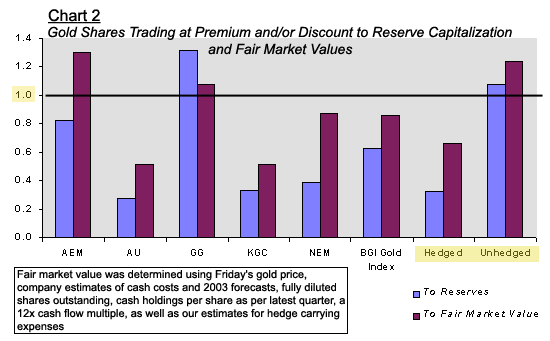
But the news is even more bullish
for the gold sector if it's a bull market; as you can see in chart
2 above, the hedgers paying attention to their share values must
notice as you do that they can achieve fuller market valuations
by ridding themselves of their hedges simply by looking at their
competition.
 In
Newmont's case (this is not a prediction), if we're right about
the above hypothesis, the stock could trade back up to $30 per share
- even assuming gold prices, or the outlook for gold prices, don't
change. But then, if the implications for gold weren't obvious before,
they are now: Newmont is a believer in the bull market. In
Newmont's case (this is not a prediction), if we're right about
the above hypothesis, the stock could trade back up to $30 per share
- even assuming gold prices, or the outlook for gold prices, don't
change. But then, if the implications for gold weren't obvious before,
they are now: Newmont is a believer in the bull market.
Cautionary note: this
is neither a forecast nor analysis of Newmont. It is an analysis
of the implications for the gold sector. There are other factors
to consider for an investment in Newmont shares. Operating Engineer's
Local Union No 3 in Elko County Nevada went on a two day strike
over pay and safety issues with the company for instance. They've
since gone back to work last we heard, but the situation bears
watching. Moreover, Mineweb reports that Newmont still has to
write down some goodwill, which will lead to a higher debt to
equity ratio, and might result in an equity issue towards yearend.
Though, the verdict on that is out, because Newmont explains that
the goodwill is actually a new category of asset - not quite reserves
and not quite an intangible - as a response to changing
SEC regulations.
Also obvious by chart 2 above is
that both Anglo and Kinross (despite Kinross' relatively small hedge)
have at least as much to gain from a hedge liquidation as Newmont
does.
Barrick wasn't included in chart
2, but it's trading at around the average. Were
Barrick able to liquidate a large quantity of its hedges this year,
it would have enormously bullish implications for its own share
values, since they also may have a hate premium attached. That's
the message here folks.
Newmont's announcement may mark the
beginning of another phase of this bull market, where the attitudes
of all the (hedged) producers shift from delaying, to acting decisively.
After all, for two years now the market has made increasingly clear
the incentives for making that decision. And that could slap the
Cabal right in the face. In a gold bull market, I believe we will
soon see, the cabal is irrelevant!
The comeback
in gold stocks Friday is in no small way related to these developments.
But so too has the war premium stopped
deflating - or at least traders have realized it's hard to make
money trading it. And the US dollar can't find traction, despite
about a 20% correction in gold prices. Now, at the opening bell
Monday morning, S&P futures are off 14 points.
Another bullish factor could be that
the speculative froth - from the January run up to $390 - has largely
been weeded out now. Andy Smith (precious metals analyst), for instance,
called on a big gold bear last week, so maybe we've shaken out the
weak hands...
Smith makes the typically boring
bearish argument that the central banks simply want to sell all
their gold, but have decided to mercifully subsidize the producers
who apparently had lobbied the central banking community for the
Washington Agreement in 1999 (good through 2004) - restricting the
central bank selling of gold to tranches instead of all at once.
Uh, huh. Subsidizing producers? Which
ones? Do the central banks have favorites? Because some of the ones
Smith's thinking would apply to are getting strangled by their hedges.
And what of the bankers that have all their interest rate derivatives
fixed to benefit from a low interest rate environment? How are the
central banks subsidizing them? The main group benefiting from rising
gold prices are the unhedged gold producers, and their shareholders.
Should the central banks continue
"subsidizing" this group, then, they risk problems at
some of the larger producers, as well as the bullion bankers vulnerable
to the impact from higher gold prices and therefore interest rates.
Sorry, we have to reject Smith's theory on grounds, well, that it
sounds stupid. It involves an institution subsidizing a relatively
small sector at the expense of the main sector it is trying to protect?
Let's stop wasting our time and consider
the other side of the coin.
Putting aside the obvious issue of
deliberate gold price manipulation, and disinformation, or not,
here's another possibility.
The Washington Agreement was put
in place to keep central banks - and other players taking their
lead - from liquidating their gold too quickly, or from getting
the wrong signal from the Bank of England's announcement in the
spring of 1999 to liquidate the remainder of its own gold reserves.
That doesn't mean producers weren't
lobbying for it to happen. It just means that's why the central
banks agreed to it.
It's not a matter of whether gold
is a good asset. We already know it's not an asset. It's money -
in the economic sense, rather than the physical or legal sense.
In fact, it's because gold has no
intrinsic value as an asset, or capital good, that it is
ideally suited to the task. It's simply the commodity most treasured
by the consumer, and in a free market environment where government's
intervene and devalue their currencies for political gain, due to
its unique monetary characteristics, it is a terrific barometer
of the dollar's value also.
But I suppose it doesn't matter how
many times we superimpose an upside down gold chart over the dollar
(index) chart, in order to highlight this relationship. Smith and
other bears argue that a technology revolution combined with the
perfection in central banking policy over the years has made the
dollar invincible. What can we say to that, except hogwash.
Gold moves forecast movements in
the dollar. They have for as long as the charts go back, but for
a few exceptions. They also tend to lead commodities, and ever since
the mid seventies gold has maintained its lead on commodities even
if the premium has come down somewhat through the past 20 years.
Note the long term trend below.
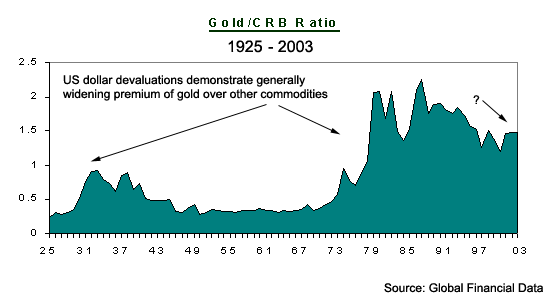
The United States has had two major
dollar devaluations in the 20th century. The first was after the
1929 stock market crash, and the second came after the Nifty Fifty
(tech stock bubble) crashed in the late sixties / early seventies.
The dollar's value was rigged in both instances, so the subsequent
results were rather extreme (imbalances pent up). Guess how they
were rigged in both cases? The US government had a mandate to fix
gold prices. Actually, it was to fix the dollar, but the inference
is clear. It was done by manipulating gold.
Consequently, the imbalances accumulated
until in 1934 FDR had no choice but to confiscate the right to own
gold, and in the 1969 period, the London Gold pool was disbanded.
Andy Smith would like us to believe
we live in a world where central bank professionalism and technology
have made gold irrelevant. But the reality is we live in a world
where profuse inflation policies (or bubble economics) lead - time
and again - first to an overvalued dollar, then to dollar devaluation.
Smith says Greenspan and co. have
created the ideal money for the capitalist system to thrive. We
argue corrupt monetary policies have undermined that process, and
strain it every day.
Smith works for the establishment.
But he couldn't tell money from cow poop.
The technology revolution is bullish
for gold, because it will uncover the lies, the nonsense, and the
deceit. All of them, one by one.
However, one mustn't forget that
it's a two way street. Technology has empowered the market, but
it has also empowered the market's enemies. The gold bull market
is destined to drag out until the truth in matters of money has
amassed critical momentum, and the economy has healed itself of
the malinvestments that plague it.
But let this truth stand no opposition.
Twentieth century monetary policies have "driven" gold
demand (and values) like no other century ever has. Let the central
banks sell their remaining piddly gold reserves into that ongoing
fact.
Edmond J. Bugos
|

